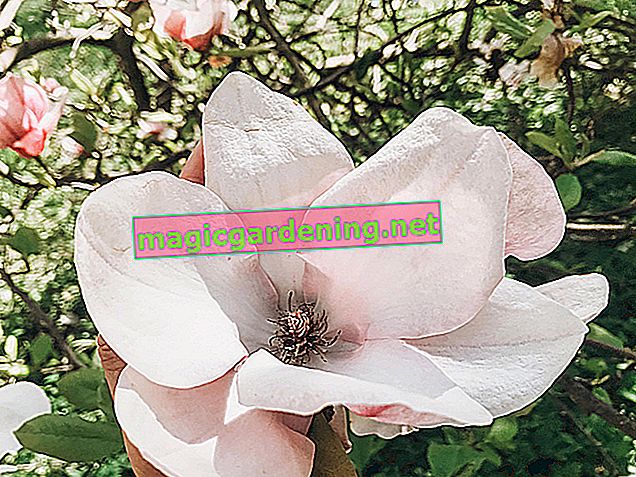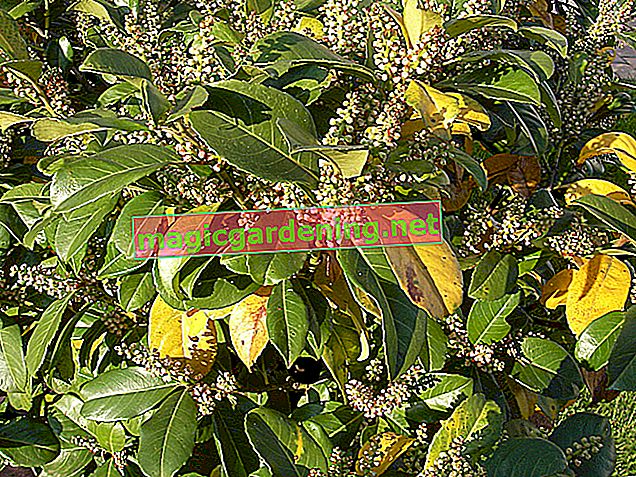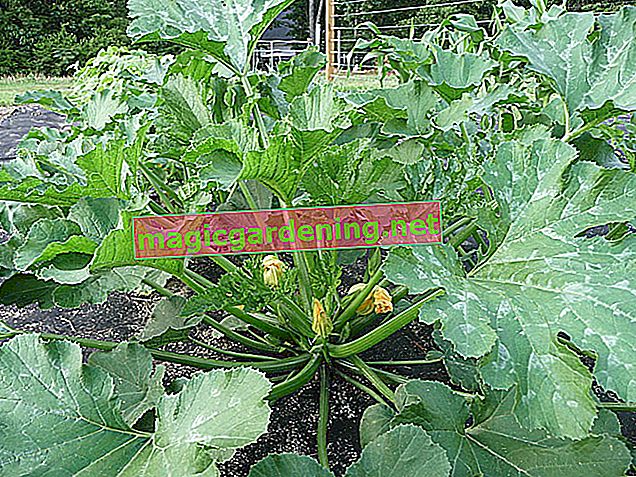
Plant horn clover correctly
So that meadow horn clover fulfills its intended task in the garden to your full satisfaction, the following aspects must be observed when planting:
- In the sunny place with sandy-loamy to gravelly earth, create small pits 25 cm apart
- If necessary, enrich the excavation with sand or fine gravel
- Pot the root ball soaked with water, plant down to the lower pair of leaves and water
also read
- Horn clover inspires with a long flowering time
- Horn clover is not poisonous
- The common horn clover - an old medicinal plant in the profile
To properly plant a lotus species in pots and balcony boxes, create a drainage under the substrate to prevent waterlogging. To do this, spread potsherds or grit (€ 12.80 at Amazon *) over the water drain before filling in the potting soil. The planting distance in the container may be 10-12 cm, because here the long tendrils dangle casually over the edge.
Care tips
The cultivated horn clover species defines the exact care program. We have summarized the pivotal points in the cultivation of both hardy meadow horn clover and non-frost-resistant conspecifics for you here:
- Water regularly with normal tap water during growth and flowering
- Water less during hibernation; Do not let the root ball dry out
- From March to August, fertilize organically every 14-21 days
- Clean up withered flower stems to motivate horn clover to re-bloom
- Only cut the leaves when they have withered
Meadow horn clover is frost-resistant, so that the plant in the bed can get through the cold season in good health. Mediterranean species such as Canarian horn clover or Crete horn clover spend the winter in a bright, cool room at 5 to 8 degrees Celsius. If common horn clover adorns a balcony box or the hanging basket, the perennial is also relocated to a light, frost-proof room for reasons of caution.
Which location is suitable?
In the sunny location, the floral display of horn clover leaves nothing to be desired. The more sun the leaves and flowers can soak up, the more intense the blaze of colors and the longer the flowering time. Assign meadow horn clover a place in the sun-drenched rock garden, along the edge of the wood or in the wild perennial bed. Frost-sensitive species thrive splendidly in the tub, the balcony box or the traffic light on the summery south-facing balcony or in the bright winter garden on the south side.
The correct planting distance
Since meadow horn clover and conspecifics usually thrive lying down and creeping, we recommend a planting distance of 25 cm. To green a larger area with the pretty shrub, ideally arrange 16 plants per square meter. If the distinctive pod clover decorates the planter, you are well advised to keep a distance of 10-12 cm, as long as the tendrils dangle decoratively.
What soil does the plant need?
First class permeability is the most important attribute for the right soil. Meadow horn clover and colleagues thrive as deep roots and at the same time form runners. Too dense soil consistency could hinder growth. If you choose a location with humus, fresh and moist soil, the ornamental plant leaves nothing to be desired. In the pot and balcony box, structurally stable potted plant soil from specialist retailers perfectly meets the requirements.
What is the best time to plant?
The best time to plant horn clover in the garden bed is in autumn, as the plant quickly takes root in the sun-warm soil. If you miss this date, plant the small perennial outdoors in April / May, when there is no longer any threat of frost. Cultivated in the traffic light, the flower box (13.18 € at Amazon *) or the tub in the winter garden, it is planting time for Mediterranean lotus species during the entire vegetation period.
When is the flowering time?
As a lush small shrub, common horn clover delights us in meadows and borders with a never-ending flowering period from April until well into autumn. If the non-winter-hardy species, such as Canary Horn Clover, find a home in the protected ambience of the winter garden, the flowers here last for a similar period of time. This floral feat succeeds mainly thanks to the remounting property. Cut out dead flowers, sprout new buds within a short time and initiate an enchanting re-bloom.
Continue reading
Cut horn clover correctly
Meadow horn clover and its annual and perennial conspecifics have the ability to remount. Botanists use this term to describe those ornamental plants that can produce a re-bloom. The targeted use of the secateurs thus makes an important contribution to a long flowering period. How to do it right:
- Cut off the withered stems after the main flowering
- The foliage is not cut
- You can either seed the second bloom or shorten it before autumn
- Woody subshrubs such as Lotus berthelotii should be cut by at least half in spring
The evergreen foliage of perennial meadow horn clover adorns the otherwise dreary garden for many months to come. In early spring, cut off the withered leaves to make room for fresh shoots.
Pour horn clover
Water meadow horn clover all year round, as soon as the soil in the bed and pot dries on the surface. Then the distinctive perennial retains its decorative foliage well into winter. If the cold season is characterized by freezing, where it freezes freezing and does not snow, watering is essential on mild days. Since the plant favors calcareous soil, the water from the tap can be used without any problems.
Fertilize horn clover properly
During the growth and flowering period, meadow horn clover gratefully accepts a portion of compost every 14-21 days. Cultivated in a balcony box or pot, commercially available liquid fertilizers meet all the requirements for a balanced supply of nutrients. Avoid the administration of nitrogen-stressed fertilizers, as these only promote leaf growth, which is at the expense of the abundance of flowers.
Overwinter
Winter hardy and frost-sensitive species can be found within the diverse plant genus. You should therefore orientate yourself exactly which type of horn clover you keep in order to take appropriate precautions. Pay attention to:
- Cover frost-resistant meadow horn clover in the bed only in rough areas with leaves
- Cultivate Mediterranean species in a planter and put them away before the first frost
- Winter bright and cool at a maximum of 10 degrees Celsius
- Reduced watering and do not fertilize
The majority of the butterflies require a cold stimulus for flower induction. Ideally, the temperatures in the winter quarters therefore fluctuate between 5 and 8 degrees Celsius.
Propagate horn clover
The single-variety propagation is uncomplicated by dividing the root ball. Dig up the perennial widely in autumn. Placed on a firm surface, cut the bale in half. At the new location, place the segments in loamy-sandy soil, maintaining the previous planting depth.
Horn clover in the pot
The pleasing attributes of horn clover come into their own in the traffic light or the balcony box. The tendrils lying in the bed hang elegantly over the rim of the vessel, covered with yellow butterfly flowers. In a sunny location, planted in high-quality potted plant soil and provided with a drainage made of potsherds, these care measures are required:
- Water daily if necessary during summer drought
- Apply a liquid fertilizer for flowering plants every 14 days from April to August
- Regularly clean withered flowers
In autumn, cut the plant close to the ground and move the pot to a light winter area. At temperatures of 5-8 degrees Celsius, only enough water is poured to prevent the root ball from drying out. Horn clover does not receive fertilizer.
Is horn clover poisonous?
Although horn clover is not one of the classic medicinal plants, like fenugreek, which is distantly related, the plant is still used in folk medicine from time to time. In addition to its primary use as a decorative small perennial for lush beds, colorful flowering meadows and the eye-catching balcony, the petals act as a rich forage plant. Horn clover cannot be said to be toxic. The leaves and flowers are only toxic to voracious snails.
Continue reading
What types of horn clover are there?
The genus gives us more than 150 species that have flexibly adapted to the most varied of habitats. Horn clover can be discovered in lush meadows as well as on sandy coasts or in the cool high mountains. We have put together some of the most beautiful species for you in the following overview:
- Common horn clover (Lotus corniculatus): yellow flowers, single or double over innumerable leaflets; Height 10 cm
- Canarian horn clover (Lotus berthelotii): creeping, evergreen, orange flowers, not hardy; Height of growth 20 cm
- Spotted horn clover (Lotus maculatus): yellow-brown flowers over silvery hairy foliage; Growth height 10-20 cm
- Marsh horn clover (Lotus pedunculatus): ideal for permanently moist locations, yellow flowers in summer; Growth height 20-90 cm
Also a butterfly and legume, fenugreek still belongs to a different genus than horn clover. The reasons for this distinction are obvious. Fenugreek thrives as an annual herbaceous plant and has enjoyed great popularity in folk medicine since the Middle Ages.
How do I fight horn clover in the lawn?
A welcome pasture for butterflies and bees in meadows, borders and rock gardens, horn clover is not desired in the lawn. Here the small perennial is considered a weed and is fought vigorously. Repeated, deep mowing has the opposite effect, because this measure even promotes the growth of meadow horned clover. To put an end to the invasion:
- Work on small infested areas with the weed cutter to remove the deep-reaching roots
- Lift out large areas of clover with a spade and re-sow
- Mow, scarify, sand and fertilize the lawn briefly if it is spread out extensively
If you are dealing with a die-hard colony of horn clover, specialist shops have effective herbicides available. The lawn weed killers Banvel from Compo or Anicon Ultra from Celaflor have proven their worth.
Continue reading
How do you grow fenugreek?
If you follow the recommendations of the legendary healer Pastor Kneipp, you cannot avoid the cultivation of fenugreek. After Hildegard von Bingen had already praised the healing power of the seeds, flowers and leaves, Pastor Kneipp triggered a renaissance of the annual herb and food plant. How to properly grow fenugreek:
- From March sowing in a sunny bed in rows at a distance of 15-20 cm
- Sieve over the seeds approx. 1 cm, press down and moisten with a fine effervescence
- Depending on the temperature, the germination time takes 1-2 weeks
- Water regularly and fertilize organically
Even the tender seedlings are used in the kitchen as a side dish for salads and soups. The leaves make a healing tea or a tasty vegetable. The seeds, which are ripe in September, are ground into a powerful spice or used as a poultice to alleviate respiratory diseases.
Continue reading








